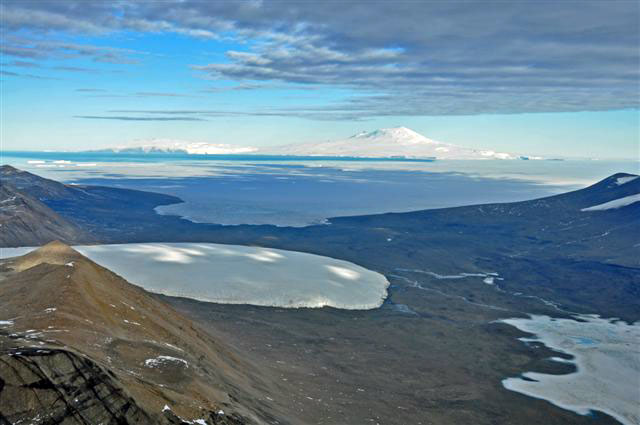|
Drawing it outScientists link salty soils to wet patches in the McMurdo Dry ValleysPosted March 16, 2012
Permafrost geologist Joseph Levy The discovery that the salty soils in Antarctica’s largest ice-free region can draw moisture out of the atmosphere to create wet patches of ground was made during a walkabout of Taylor Valley a couple of years ago while Levy was a Polar Regions Research postdoctoral fellow He and colleagues noticed patches of wet and damp soil — but it was well below freezing that day. Scratching their heads — and being curious, as scientists are — they collected some of the dirt and analyzed the samples. More Information
The soil was full of hygroscopic salts — substances that hold water molecules really well — including calcium chloride, magnesium chloride, even common table salt, sodium chloride. “These are all salts that when you expose them to high relative humidities, will suck water right out of the air,” explained Levy, now a post-doctoral researcher in Oregon State University’s College of Oceanic and Atmospheric Sciences The study, which was supported by the National Science Foundation Levy said the process was first predicted more than 30 years ago by scientist Alexander Wilson at Victoria University of Wellington “It looks like the process happens everywhere in the Dry Valleys that you have these wet patches,” Levy said. “It’s how Antarctica got its spots. It’s pretty common.” A simple experiment confirmed the hypothesis. Levy put the salty soils into one jar and water into a second jar, then sealed both into a plastic container. The soil was soaking wet after a couple of days. 
Photo Credit: Kelly Speelman/Antarctic Photo Library
An aerial view of Taylor Valley looking toward McMurdo Sound and Mount Erebus.
“The same thing happens in the Dry Valleys,” he said, adding that the process only requires high humidity to act as a catalyst. Once a brine forms by sucking water vapor out of the air, the brine will keep collecting water vapor until it equalizes with the atmosphere. And where there is water, there is life. “We know those wet patches are little oases in the cold desert,” Levy said. The carbon content is about 30 times higher than in adjacent areas, providing plenty of fuel for microorganisms inhabiting the soils. The find has implications for scientists interested in understanding how far out places like Mars might support life. In fact, the Mars analog to the Dry Valleys might explain the appearance of dark stripes found along the slopes of Martian mountains during the spring and summer. Levy said the pattern is similar to the one displayed by liquid brines moving over the permafrost surface of the Taylor Valley. “Every year, Mars looks more like Antarctica to me and Antarctica looks more like Mars,” Levy said. NSF-funded research in this article: Joseph Levy, Oregon State University, Award No. 0851965 |



For USAP Participants |
For The Public |
For Researchers and EducatorsContact UsU.S. National Science FoundationOffice of Polar Programs Geosciences Directorate 2415 Eisenhower Avenue, Suite W7100 Alexandria, VA 22314 Sign up for the NSF Office of Polar Programs newsletter and events. Feedback Form |


